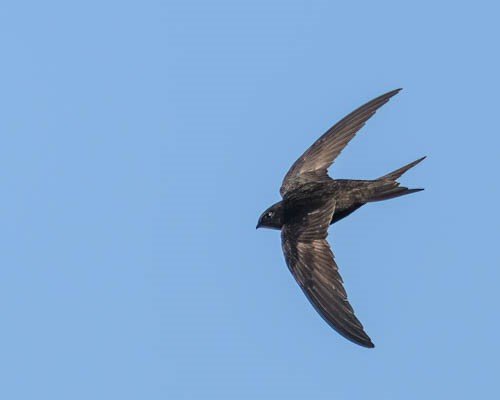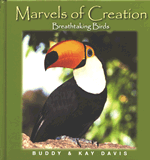The Miracle of Flight
Despite all our advances with human flight, we don’t come close to matching the wonder of birds and their feathered flight.
We’re warned that curiosity killed the cat, but we can’t help but wonder why. It’s our nature. For as long as history has been recorded, people have been curious to know how things work, a desire exceeded only by a need to do it ourselves. Lightning strikes, igniting a tree, so man rubs two sticks together to achieve the same thing. A bird soars through the sky, riding on air currents, looking weightless and untouchable. If only we could do that!
After thousands of years of dreaming and failed attempts, people finally figured out how to stay airborne just over a century ago. Airplanes now fill the skies across the globe, but not with the grace of birds. Fixed-wing jumbo jets must lumber down two-mile-long runways for takeoff, while others circle in the air waiting their turn to ease down for a landing. (Woe to the traveler who’s stuck in the air when snow shuts that runway down!) Meanwhile, thousands of air traffic controllers must keep constant watch to prevent crashes. At the same time, a bevy of support crews bustle about to keep the planes clean, fueled, repaired, and upgraded.
This technology is amazing, but how far we are from flying like birds! Take another look at the birds outside: a hawk soaring effortlessly far overhead, turning with a flick of its wing; or a flock of roosting sparrows that takes flight in unison; or a joyous songbird flitting through thick trees without a care in the world about damaging its wings.
We can get airborne, sure, but we have no panache. Comparing modern planes to birds is akin to comparing your child’s finger painting to Leonardo da Vinci’s Mona Lisa. Yes, your little munchkin is talented and has come a long way, but a grand master she is not.
It may be many moons—if ever—before we make a machine that flies like a bird. Scientists still can’t even understand how birds do it, let alone imitate them. As they learn new things, they copy a few details here and there, but not the whole package. You never see a plane beating its wings just like a swift, or soaring as effortlessly as a hawk, or flitting through the woods like a robin. What a testimony to the skill of the Creator, and what a challenge for humans to keep studying His handiwork!
Why We Can’t Fly Like a Bird
Though we have dreamed of human-powered flight since the ancient Greek myth of Daedalus, it has only been a dream. We just don’t have the power in our arm muscles. For us to fly, we’d need to sprout wings 140 feet (43 m) long and chest muscles 6 feet (2 m) thick!
Leonardo da Vinci (1452–1519), brilliant as he was, made the same mistake as his predecessors. He assumed flapping their wings keeps birds aloft. But kites can fly for hours, and they don’t flap! The science of flight took off in 1799, when Sir George Cayley proposed that humans could fly by making a separate power source to thrust the craft forward, while fixed wings would provide the “lift.” His design was essentially a kite mounted on a stick with an adjustable tail. Wilbur and Orville Wright finally made a motor light enough to thrust a plane through the air. Their inaugural flight on December 17, 1903, lasted a grand total of twelve seconds over 120 feet.
But birds don’t fly like this. They don’t have a separate engine. Their wings provide both the thrust and the lift. To accomplish both purposes, the wings must move and contort in an infinite variety of ways. Scientists have identified the basic equations of aerodynamics to enable planes to fly, but they still can’t get the math to work to explain what birds do, let alone knowing how to imitate God’s flying machines.
Evolutionary biologist Anders Hedenström gives a good, technical description of the miracle of bird flight compared to human flight: “[Unlike flight by an aircraft] animals generate lift and thrust by flapping their wings, which continuously change shape . . . throughout the wingstroke. An analytical solution of Navier–Stokes equations . . ., which describe the aerodynamic forces that keep fliers aloft, would, in principle, solve the problem of how birds fly, but a solution to these equations defies scientists to this day” (Journal of Experimental Biology, 2009).
Lift is a complex topic. A chap named Bernoulli (1700–1782) was the first to work out the details. The faster air moves over the top of a wing, the lower the air pressure. Once the wing is moving fast enough, the higher air pressure under the wing will have enough force to push it up (“lift”). Although they don’t know the equations, birds have been applying this law ever since creation.
Calculating the lift of a plane is fairly simple because the plane’s parts don’t move. The ever-changing combination of forces on a bird, in contrast, is so complex that humans haven’t even been able to observe them directly until last year! Imagine what it would take to record the changes in a bird’s wing shape in flight. A researcher at Stanford University, David Lentink, developed a super-sensitive wind tunnel with cameras that can record 7,500 images per second. He believes his research may uncover whole new technologies that we’ve never dreamed of.
Shaping Up for Flight
Although we still can’t fly like birds, we keep learning astonishing things from them. Genesis 1:21 says God created “every winged bird according to its kind” and it was good. Each bird flies across the sky in its own unique way that perfectly matches its specific needs. The examples are endless, but we’ll consider three common bird designs that still blow scientists away.
Wings designed for high speed are long and thin. Such a design allows these birds to sustain high speeds for a long time.
The Speedy Swift

Swift in flight by Colin Mitchell
Probably the most familiar shape for a bird wing is that of a swift. The wings are streamlined and swept like the wings on a jet fighter, and for good reason. The swift spends eight hours per day nabbing insects midair, so it needs to make tight turns and sustain maximum speeds for long periods of time. Unlike jet fighters, which can burn up to 385 gallons of fuel per minute and may need to refuel after less than an hour, some birds, like the great snipe, can fly nonstop at speeds of 60 mph (97 km/hr) for 4,200 miles (6,760 km).
Swifts are the fastest birds ever recorded in level flight, reaching a maximum of 106 mph (171 km/h). Peregrine falcons are twice as fast, but they reach these world-record speeds by dive-bombing, not flapping their wings. How do swifts do this?

The peregrine falcon is the fastest animal on the planet. During steep dives to catch food, it can reach speeds up to 200 mph (320 km/hr).
The peregrine falcon is the fastest animal on the planet. During steep dives to catch food, it can reach speeds up to 200 mph (320 km/hr).
The secret to achieve such lift and dexterity with so little output of energy is wing design. A bird’s wings have a similar asymmetrical shape to an airplane’s wings, with the top half curving much more than the bottom. However, a bird’s wing has several key differences.
For one thing, a bird’s wings are covered with feathers arranged like roof shingles. They press together during the downstroke so no air flows through, and then they spread apart on the upstroke so the air can pass through. A network of muscles, ligaments, and bones allows birds to move their feathers to change shape.
A bird wing essentially has two parts, the part near the body and the outer section. The part near the body provides most of the thrust, and the outer section provides most of the lift.
Their body is specially designed to distribute the weight so it maximizes power output. The larger muscles are close to the bones and near the center of mass. The inner portion of the wing does most of the work in powering the bird. The muscles that pull the wing are close to the center of the body to minimize the energy required. You wouldn’t want to hold out your arms and then flap with just your hands!
Even though their wings are constantly changing shape and direction, birds maintain their path so smoothly that you don’t even realize the changing forces throughout each stroke. As they flap, twist, and fold each wing, their bodies would zigzag like a crazy pinball unless each tiny force was balanced perfectly with a counter force.
Wings designed for passive soaring have long feathers that spread out to catch rising air currents.
The Soaring Hawk
Another marvelous master of flight is the hawk, famous for its designs to soar. This is not the same motion as flapping, and it allows for the minimum use of energy for sustained periods of time, as hawks patiently glide above the vegetation, looking for prey. Their wings are long and broad, like gliders, giving them maximum surface area to catch rising warm air currents. God gave these birds the wings and instincts necessary to take advantage of hidden sources of energy in the motion caused by moving air. Humans have learned new, energy-saving techniques from hawks and other soarers.
In the 1920s, observers realized that birds’ wing feathers spread out to create “slots” that allow them to catch rising columns of hot air called thermals (a technique known as thermal soaring). When you see a hawk circling and rising without flapping its wings, that’s what it’s doing, as the sun heats the earth and air rises like a dust devil. Hawks can climb hundreds of feet without expending any energy.
In the 1990s, pilots of radio-controlled gliders figured out a valuable technique from hawks, called dynamic soaring. They’ll soar downwind, then turn quickly into a gust and be buffeted upward. They can do this for miles, bouncing back and forth on gusts. Bird watchers had earlier discovered that hawks can detect air rising up mountains, buildings, and even trees to lift them higher (a technique known as “slope soaring”).
The wing shape of the red-tailed hawk lets it soar in slow circles above the ground as it searches for prey.

The wing shape of the red-tailed hawk lets it soar in slow circles above the ground as it searches for prey.
No wonder God pointed to the hawk when He wanted to humble Job about the wisdom He displayed in nature that man can’t imitate: “Does the hawk fly by your wisdom?
” (Job 39:26). Even the commonplace birds can do energy-saving maneuvers that put airshow pilots to shame.
Short, rounded wings give robins and finches agility and short bursts of speed to avoid predators and catch insects.
The Flitting Robin of the Forest
The beautiful robin may spend only a few minutes in the air each day. It spends most of the time perched near or on the ground waiting to spy a worm or insect in the grass. Its short, rounded wings allow for quick bursts of speed and sharp turns to grab food or get away from a hawk.
We take for granted what these birds can do, but no planes could match them. They’re able to locate prey and brush through thick vegetation to grab it. Bumping into leaves and branches isn’t a problem since their feathers simply retract on impact.
How different this is from fixed, hard wings on planes! Engineers are testing ways to make wings that retract on touch, too, but they are still in the experimental stage with little plastic models of wings.
The zebra finch has a distinct flight pattern that bounces up and down as it flaps then folds its wings for a split second.

The zebra finch has a distinct flight pattern that bounces up and down as it flaps then folds its wings for a split second.
In 2001 NASA engineers met on the future of flight and decided they needed to develop “smart materials” that can change shape on command. They haven’t gotten far, but it’s a cool idea, anyway.
The wings are just one aspect of birds’ unique designs that exceed anything humans can reproduce. What plane can nail a landing on a tree branch? What plane can sustain injury and heal itself, restoring the delicate balance needed for flight? The list goes on and on, like birds’ breathing system—the most efficient in the animal kingdom—that keeps its high-efficiency motor running. All these systems had to be in place from the beginning for birds to fly and not crash and burn.
Flocking to Alternatives
Since the Garden of Eden, God’s designs have inspired mankind to dream of new possibilities. Who would ever have attempted heavier-than-air flight without first seeing a bird?
As green sciences gain more and more notoriety, the field of biomimicry (science imitating nature) is growing at an exponential rate. Designing technology based on God’s creation is science at its best, honoring its Maker.
Airplanes were just the first step. Biologist and engineer David Lentink realizes that we still have much more wisdom to glean from creation: “Compared to a bird, the aeroplane is a primitive thing in which all the functions are separated. . . . In the bird everything is integrated.” He has devoted his life to studying how all these parts work together and expects to discover completely new insights about the world and physics.
The potential benefits of his research are staggering. Imagine constructing a robot capable of changing shape during flight. Flying cell phones, robotic carrier pigeons—all that and more may be possible.
No matter how much mankind discovers, however, there will always be more to learn. The infinite depth and detail of God’s wisdom, displayed in His creation, was designed to provoke humility and eternal praise of the One who created it all. God’s fingerprints are clearly visible everywhere we look, including on something as simple as a songbird flapping its wings in our backyard.

photo Power and Syred / Science Source
Close-up of the microscopic hooks and matching ridges that give feathers strength and flexibility.
Magnificence Under the Microscope
Engineers are constantly finding new ways to combine substances into stronger, lighter, more elastic building material. This allows for ever-more impressive stealth fighters and ultralight aircraft. But we’ll never come close to duplicating the basic building block of bird wings—feathers.
Photo above: Close-up of the microscopic hooks and matching ridges that give feathers strength and flexibility.
Unlike man-made materials, feathers become more impressive the closer you look at them. Feathers consist of microscopic moving parts, which give them unparalleled flexibility and strength.
Under a microscope, you’ll discover a network of small branches (called barbules) evenly spaced in an interlocking, crisscross pattern. The branches connect to each other by a series of hooks and ridges. A single feather contains millions of these hooks (called barbicels).
Each hook is actually a moving joint. At the base of the hook is a hinge that helps the hook latch onto the corresponding ridge. This flexible design allows feathers to catch the air on the downstroke, but air passes through the feathers on the upstroke.
If the connections snap apart, the bird simply draws its beak through the feathers, and the hooks lock back into place, like a zipper.
The bird must oil these joints to keep them from fraying. So it rubs its beak on an oil gland at the base of its tail, and then spreads the oil through the feathers. How could flight evolve unless all these parts appeared together at the same time? The Designer must have put them there, all at the same time.
Related Videos
Creation Museum Collection: Life: Designed for Flight
Answers Magazine
July–September 2016
How did Noah build the ark? This issue explains how Noah had technology to build a massive Ark and how eight people could care for so many animals.
Browse Issue SubscribeRecommended Resources

Answers in Genesis is an apologetics ministry, dedicated to helping Christians defend their faith and proclaim the good news of Jesus Christ.
- Customer Service 800.778.3390
- © 2024 Answers in Genesis





